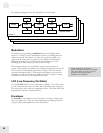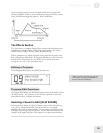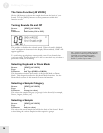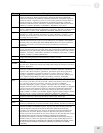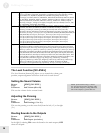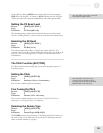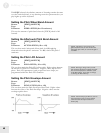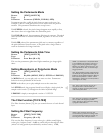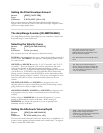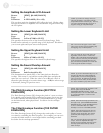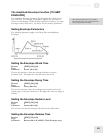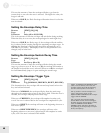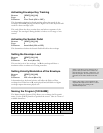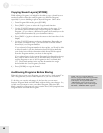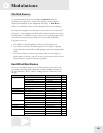
7
Editing Programs
42
positive modulation won’t have any affect, since the filter is already
“maxed-out”.
Turning On Filter Keyboard Tracking
Button: [EDIT] [70 FILTER]
Page: 2
Parameter: Kbd Track (ON or OFF)
This sets how the filter frequency tracks across the keyboard.
When OFF, the filter frequency remains constant across the keyboard.
Higher notes will be more filtered than lower notes, since they have
higher frequency components.
When ON, the filter frequency will track the keyboard pitch. When you
play a higher note, the filter cutoff frequency will automatically be raised
to compensate for the higher note.
Setting Velocity Filter Tracking
Button: [EDIT] [70 FILTER]
Page: 3
Parameter: VELO>FILT (-99 to +99)
This sets how much keyboard velocity affects the filter frequency. At
positive values, playing harder raises the filter frequency, resulting in a
brighter sound. At negative values, playing harder lowers the filter
frequency, resulting in a darker sound.
Setting the Mod Wheel Filter Depth
Button: [EDIT] [70 FILTER]
Page: 4
Parameter: MODWH>FILT (-99 to +99)
This sets how much the modulation wheel affects filter frequency. At
positive settings, moving the modulation wheel up raises the filter
frequency. At negative settings, moving the wheel up lowers the filter
frequency.
Setting the Aftertouch Filter Depth
Button: [EDIT] [70 FILTER]
Page: 5
Parameter: AFTCH>FILT (-99 to +99)
This sets how much aftertouch affects the filter frequency. At positive
values, applying aftertouch raises the filter frequency. At negative values,
applying aftertouch lowers the frequency.
Setting the Filter LFO Amount
Button: [EDIT] [70 FILTER]
Page: 6
Parameter: F-LFO>FILT (-99 to +99)
This sets how much the Filter LFO affects filter frequency. Higher
values increase the amount of filter LFO modulation. Negative values
flip the LFO phase.
NOTE: If you don’t hear any change when
you edit this and other filter parameters,
make sure the Filter Frequency is not
already “maxed-out”, i.e., it has room to
move in the direction you specified.
NOTE: If you hear
no change when you
alter this parameter, experiment with the
Filter LFO Functions on button [7]. You
may get a more pronounced effect if you use
a negative setting for Filter LFO Depth.
TIP: Many acoustic instrum
ents, such as
acoustic guitars, sound brighter when you
play them more forcefully. Adding a little
positive velocity control over the filter
frequency can more accurately simulate
these instruments.
TIP: Filter LFO is good for giving wah
-
wah
effects at s
lower LFO speeds, and for adding
“shimmering” at higher speeds.



